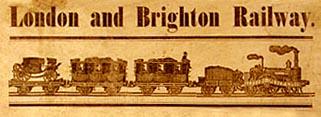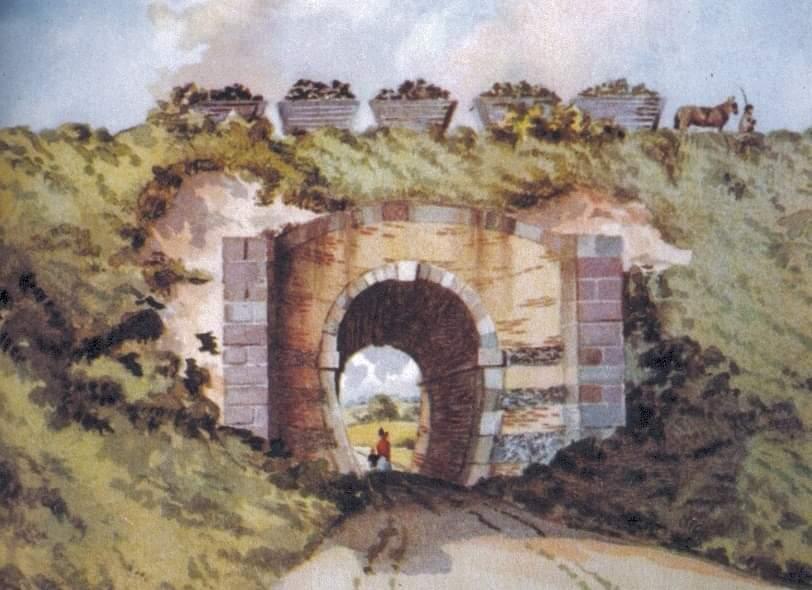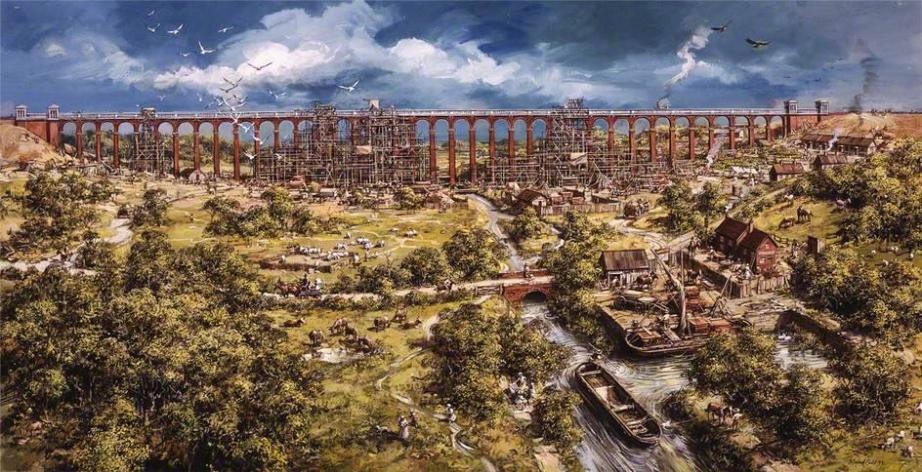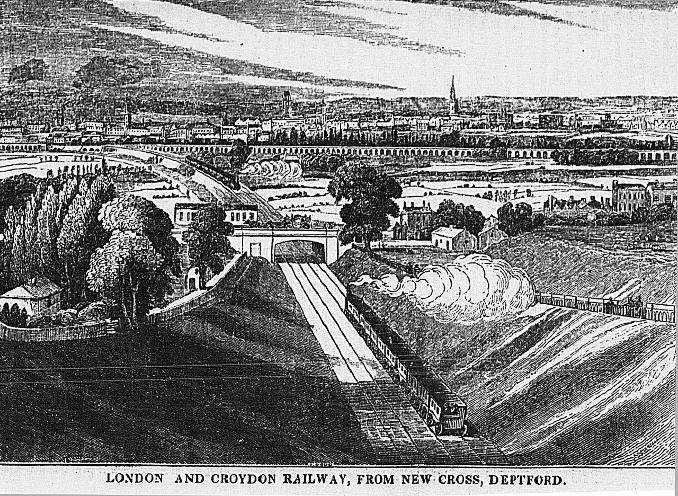

For the history of the railways have been well charted, but what do we know about the
pioneering Enginemen who worked on the locomotives on the early lines? For those first
primitive railway service were fuelled by the bloody, sweat and the unremitting hard labour
of the men who worked them; the story of the railways is their story too.
With the rapid spread of the railway network brought prosperity for the railway companies,
but only hardship and exploitation for their employees. A footplateman’s time was considered the property of his employer and he could be summoned for duty at any hour of the day and night.

The Wandsworth (Basin) to Croydon (Pitlake Mead) via Tooting Mitcham section was opened on 26th July 1803. There was a a branch of at Mitcham going to Hackbridge and Carlshalton, there was also several sidings on the line to severe the various mineral to mills and works.
The Croydon - Merstham - Godstone via Purley and Coulsdon was opened on the 24th July 1805. The line never arrived at Goldstone.
It was a public toll railway, providing a track for independent hauliers to use their own horses and wagons. The wagons were pulled by mules walking between the tracks with average speed of about 2-3 m.p.h.

Painting (1823) of a Croydon, Merstham & Godstone Railway
crossing over the Chipstead Valley Road at Coulsdon
THE LONDON & CROYDON RAILWAY
Opened in 1839 and in July 1846 merged with other railways to form the
London Brighton & South Coast Railway
THE FORMATION OF THE L.B.S.C.R.
By the 1830s Brighton was the most popular seaside resort in Britain, with over 2,000 people a week visiting the town. After the success of the Liverpool & Manchester Railway, a group of businessmen decided to build a railway between the town and London.
The London & Brighton Railway Company was set up and Robert Stephenson was asked to advise on the best possible route. Six possible routes were initially proposed but eventually the choice was narrowed down to those of John Rennie and George Bidder. Rennie suggested a direct line between London and Brighton, whereas Bidder favoured a route that avoided steep gradients and tunnels. Stephenson eventually selected George Bidder's route, but the London & Brighton Railway Company decided to ignore this advice and opted for Rennie's much shorter route.
George Rennie's proposals also made more use of existing track and only involved the construction of 39 miles of new railway. However, Rennie's proposals did involve building four long tunnels at Merstham (2,180), Balcombe (800 yards), Haywards Heath (1,450 yards) and Clayton Hill (1,730 yards). This route also required the building of a viaduct across the Ouse valley near Ardingly.
In July 1837, Parliament gave permission for John Rennie's proposed railway. The London & Brighton Railway Company appointed John Rastrick as the line’s chief engineer. Rastrick had been working on locomotives since 1814 and had been one of the three judges at the Rainhill Trials. Rastrick had also worked with George Stephenson on several projects, including the Liverpool & Manchester Railway and Grand Junction Railway. However, George, like his son Robert, believed that John Rennie's route was impracticable.
The building of the line started in July 1838. The directors of the London & Brighton Railway realised the importance of linking Brighton with the harbour at Shoreham and a branch railway to it was constructed at the same time as the main line.
Extracted & adapted from
the Railway Magazine
October 1955

The construction of Ouse Valley Viaduct
Painting by Michael Codd
THE FIRST LOCOMOTIVES ON
THE LONDON & BRIGHTON RAILWAY
(1837 - 1846)
The first locomotives on the London & Brighton Railway commenced in August 1838, when
the directors met and decided to hasten up the construction by the use of steam power. The
first locomotive was appropriately named 'Brighton (1)’ (2-2-2) which travelled south from
the makers over the London & Birmingham Railway and reached Camden on the 8th January 1839. From Camden, horses hauled it by road to Shoreham, where it was employed on the construction of the Brighton to Shoreham railway line. The second locomotive was named 'Shoreham (2)’ (0-4-2), and reached Camden on the 6th April, 1839, and later it travelled by road onto Shoreham, where it too was used to for construction of the line.
Three more locomotives (2-2-2) built by Sharp, Roberts & Co., were delivered ‘Merstham
(3),’ which was delivered on the 11th July, 1839, to Merstham, this was followed by
‘Coulsdon (4)’ August 1839, these locomotives were used in the construction of the line from London to Brighton. The third locomotive ‘Kingston (5)' was delivered in November 1839, to Worth which is about four miles north of the then uncompleted Balcombe Tunnel and the headquarters of the contractors.
A further two locomotives were delivered, the first being ‘Eagle (6)’ which was held back for the opening of the line, and the second was 'Vulture (7)’ which was delivered on the 21st May 1840 and worked on the main line north of Brighton. One more locomotive was acquired for ‘train engines' and arrived in July 1840, this locomotive was named ‘*Venus (8)'.
During 1841 more locomotives were built at the locomotive works of Sharp & Roberts (12),
Rennie (1) , Fairbairn (4), Bury (6) and George Forrester (3). These locomotive along with
the original eight locomotives made up a total of thirty-four locomotives. The first six
locomotives to arrive from the Sharp & Roberts works all carried the names only and were
called ‘Jupiter,' "Mars,’ ‘ Saturn,’ ‘ Mercury,’ 'Orion’ & 'Sirius,' as their preceding locomotives did. It was not until sometime in mid 1841, that the London & Brighton Railway locomotives were given numbers as well as names, with the first record of numbers to be given was at the inquiry into the Copyhold Cutting accident of October, 1841 involving a Fairbairns, locomotive No.22 & a Bury locomotive No.17.
The new Rennie locomotive ‘Satellite,' was described in the Railway Magazine of 25th
December, 1841:
The ‘Satellite’ Locomotive: We were on Wednesday invited to a private view of an engine,
which has been constructed by Messrs. Rennie for the the Brighton. It is a six-wheeled engine to be worked expansively, and is named 'Satellite,’ for climbing inclines and for starting, it has hoppers, which by a lever can be made to convey dry sand to the driving wheels, thereby giving them more adhesion on the rails. As a piece of workmanship, ‘Satellite’ is the finest locomotive which has ever been turned out of a London workshop.
Between 1837 to 1847, locomotives had a dark green livery, with or without black bands. This was in general use during the London & Brighton Railway days, although some engines ran in other liveries. For instance the Bury goods locomotives entered traffic painted Indian Red.
The locomotives on the London & Croydon Railway were painted in a Sea Green with a
black lining with the exception of their locomotive “Hercules” which was painted in a Pale
Chocolate. In 1846 the L.B.S.C.R. was painting their locomotives a Dark Bottle Green for the passenger locomotives, whilst their goods locomotives were painted black unless they were regularly employed within sight of passenger platforms at Brighton or London Bridge. The driver was responsible for seeing that his locomotive was smartly turned out daily before commencing work. All the bars other metal work must be brightly burnished. Apparently this green varied in hue, it being found acceptable if well applied and tastefully lined out. Some engines carried brass numerals on the chimney fronts, while others had painted figures on the buffer beams. There was a similar lack of uniformly regarding other numerals, in some cases they were painted on the footplate side-sheets and in others on the sides of the boiler barrels.
* Mars exploded in Brighton on the 17th March 1853
The London & Brighton open a motive depot in here in 1838 and closed in 1840 and was used as a goods shed.
The London & Croydon Railway opened a motive power depot here in 1839. Little is known of the first loco shed, standing remotely from the station against the southeast wall of the site.
1846 the shed was relocated to the west side of the layout which had no covering over the
four shed roads and a turntable were in place. By 1870, besides six roads for carriage storage, three undercover, the loco depot now had a two-road shed with a 46-feet diameter turntable in the arrival/departure line. The shed was some 130 feet long, brick-built and ridge-roofed with raised segments.

New Cross (1839 - 1949)
The London & Croydon Railway opened a motive power depot and a locomotive repair
facility here on 1st June 1839, the former of which appears to have been particularly accident prone. The original building, one of the earliest roundhouse (Octagonal), burned down on the 14th October 1844 (SEE SUB PAGE 1844). A replacement was built in 1845, and a straight shed built by the L.B.&S.C.R. in 1848 was blown down in a gale in October 1863. Two further buildings were constructed by the L.B.&S.C.R. in 1863 and 1869. By 1882 the second (1845) Croydon shed was derelict and in that year was replaced by the new shed, which was rebuilt with a new roof by the Southern Railway prior to 1929.
The various running sheds began to be run down during the 1930s as part of a re-organisation
scheme involving new developments at Norwood Junction, but the onset of war meant that
they were not formally closed until 1947 and were used for stabling locomotive until 1951.
They were demolished in 1957 together with the repair workshops, and replaced by sidings
for the storage of electric multiple units.
The locomotive workshops established by the London & Croydon Railway continued to
undertake minor repairs on locomotives in the London area for the L.B.& S.C.R. and the
S.R., and also briefly for British Railway. They were closed in 1949 and demolished in
1958/59
THE PIONEERING ENGINEMEN OF BRIGHTON
The first record of the depot establishment at Brighton Locomotive shed comes from the London Brighton and the L. B. S. C. R. records of employees which show that in 1851, there was 46 Enginemen, Fireman and Cleaners were employed there. These records also show that only 30% were Sussex-born, while over half came from distant parts of the country.
An Engiineman was a very skilled job and so when a new line was opened during the early years of the railway building era, Enginemen were sometimes enticed from existing
companies.
The London & Brighton Railway acquired its first drivers in this way, only later training other men to join them. Engine drivers and firemen were required to be reliable and have stamina and aptitude rather than formal education.
The system by the 1850s a chain of recruitment had been established which involved an
untrained recruit, usually in his teens, starting as an engine cleaner at pay 10-12s. a week.
Then promotion to a fireman on a wage of 3s. 6d. a day (21s. per week, assuming six-day
working). After another five years or so, a fireman might be with eventual promotion to driver at 5s. to 8s. per day depending on Seniority (30s. to 48s. per week assuming six-day working).
The London & Brighton Railway acquired a large number of its earliest Enginemen in this way, by offering very good wages for a working-class man at that time, although the long hours (10 to 12 per day) and heavy responsibilities were a drawback.
Senior engine drivers were thus well paid and highly respected employees.
SOME OF THE EARLIEST ENGINEMEN OF BRIGHTON LOCO SHED